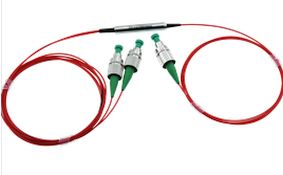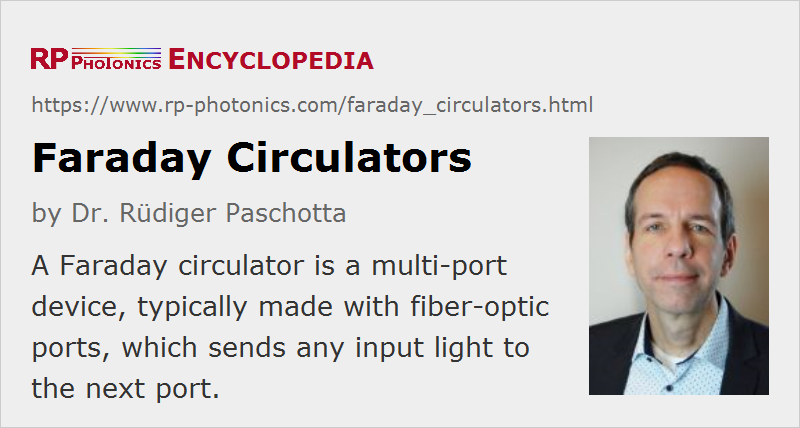Faraday Circulators
Definition: a non-reciprocal optical device sending light from each input to the next output port
More general term: optical circulators
German: Faraday-Zirkulator
Categories:  general optics,
general optics,  photonic devices
photonic devices
Author: Dr. Rüdiger Paschotta
Cite the article using its DOI: https://doi.org/10.61835/u6q
Get citation code: Endnote (RIS) BibTex plain textHTML
Faraday circulators (or less specifically optical circulators) are a kind of non-reciprocal optical devices. They are technically related to Faraday isolators, and on a broader scale similar to electronic circulators. Typically, a circulator has three or four optical ports (inputs / outputs), although there could in principle be more. These devices typically have three or four optical ports, although more can be incorporated. Light entering one port exits from the next port, or from the first port if injected into the last. For instance, in a three-port device, the light paths can be illustrated as:
- 1 → 2
- 2 → 3
- 3 → 1
Depending on the type of circulator, this may work only for specific polarization directions of input light, or in a polarization-independent manner.
In diagrams of optical setups, a circular symbol with an arrow is used to denote the direction of circulation (refer to Figure 1).
The non-reciprocal behavior is evident when light enters the device at port 1 and exits at port 2, but the reverse is not possible: light entering port 2 exits at port 3, not port 1.
Operation Principle
Faraday circulators are magneto-optic devices based on the Faraday effect – rotation of the polarization – as explained in the article on Faraday rotators. Typically, one uses a Faraday rotator with 45° rotation of the polarization, often in combination with a <$\lambda/2$> waveplate oriented such that it compensates for the effect of the rotator in one propagation direction, while for the other propagation direction one obtains a 90° change of polarization direction.
As an example, a four-port circulator can be constructed as shown in Figure 2. As explained above, the combination of Faraday rotator and waveplate in the middle will maintain the linear polarization of light moving from left to right, while rotating the polarization of light moving from right to left by 90°.
That device would not work, for example, with s polarization sent into port 1; that light would be sent to the bottom by the first polarizer, where no port is installed.
More advanced designs can accommodate any input polarization to any port, a feature often desired in fiber optics. This is achieved by creating different geometric paths through the Faraday rotator and waveplate, based on the polarization direction.
Some Faraday isolators are already equipped with an additional output port, where back-reflected light from the output emerges. However, what is missing to a circulator is that light sent into that output port gets back to the original input.
Fiber-optic and Other Faraday Circulators
Although Faraday circulators are usually bulk-optical devices, where light beams travel through homogeneous optical media (the rotator crystal, polarizers, and air), they can be equipped with optical fiber ports, each of which has a collimating/focusing lens. That makes them suitable for applications in fiber optics, such as optical fiber communications. Indeed, fiber-optic circulators are used more widely than bulk-optical variants, which are not common in bulk laser technology, but used in some areas such as LIDAR.
In numerous instances, fiber-optic Faraday circulators are equipped with single-mode fibers for use in the 1.5-μm telecom band. They are fairly compact and lightweight devices. They are available in polarizing and polarization-independent variants, and are typically suitable for some hundreds of milliwatts of optical power.
Optical circulators can also be interesting for devices made in integrated optics, e.g. in silicon photonics, but these are relatively difficult to implement in a compact form.
Various Imperfections
The above-described operation applies to a hypothetical ideal circulator. A real circulator exhibits various kinds of imperfections, which are the subject of technical product specifications:
- Insertion loss: there is some loss of optical power of light going through it. (It can be well below 1 decibel.)
- Incomplete isolation: some (usually rather small) non-intended optical powers emerging from other output ports, or reflected back to the input port (finite extinction ratio or return loss, typically several tens of decibels).
- Beam distortions: for bulk-optical devices, the wavefronts of transmitted light may be somewhat deformed.
These performance figures depend on the optical wavelength; circulators work well only within a limited optical bandwidth. One may specify lower limits of the mentioned performance factors within the whole bandwidth.
Besides, there are limitations of the power handling, optical nonlinearities (particularly the Kerr effect) and chromatic dispersion.
Typical Applications of Faraday Circulators
A few typical applications of fiber-optic Faraday circulators are briefly explained in the following:
- One can integrate a reflective fiber-optic component, e.g. a fiber Bragg grating, into a fiber-optic light path (see Figure 3). That is used, for example, in some fiber ring lasers and for signal waves in optical fiber communications systems.
- Similarly, one can realize a double pass through some device, such as a fiber amplifier.
- There are also various applications in the area of fiber-optic sensors.
More to Learn
Encyclopedia articles:
Suppliers
The RP Photonics Buyer's Guide contains 36 suppliers for Faraday circulators. Among them:


DK Photonics
DK Photonics offers polarization-maintaining fiber-optic circulators for a wide range of wavelengths between 532 nm and 2050 nm.
Bibliography
| [1] | W. B. Ribbens, “An optical circulator”, Appl. Opt. 4 (8), 1037 (1965); https://doi.org/10.1364/AO.4.001037 |
| [2] | P. C. Fletcher and D. L. Weisman, “Circulators for optical radar systems”, Appl. Opt. 4 (7), 867 (1965); https://doi.org/10.1364/AO.4.000867 |
| [3] | A. Shibukawa and M. Kobayashi, “Compact optical circulator for optical fiber transmission”, Appl. Opt. 18 (21), 3700 (1979); https://doi.org/10.1364/AO.18.003700 |
| [4] | T. Matsumoto and K. Sato, “Polarization-independent optical circulator: an experiment”, Appl. Opt. 19 (1), 108 (1980); https://doi.org/10.1364/AO.19.000108 |
| [5] | M. Shirasaki, H. Kuwahara and T. Obokata, “Compact polarization-independent optical circulator”, Appl. Opt. 20 (15), 2683 (1981); https://doi.org/10.1364/AO.20.002683 |
| [6] | E. H. Turner and R. H. Stolen, “Fiber Faraday circulator or isolator”, Opt. Lett. 6 (7), 322 (1981); https://doi.org/10.1364/OL.6.000322 |
| [7] | C. F. Buhrer, “Wideband temperature-compensated optical isolator or circulator configuration using two Faraday elements”, Opt. Lett. 14 (21), 1180 (1989); https://doi.org/10.1364/OL.14.001180 |
| [8] | J. Krasinski et al., “Multipass amplifiers using optical circulators”, IEEE J. Quantum Electron. 28 (5), 950 (1990); https://doi.org/10.1109/3.55537 |
| [9] | Y. Fujii, “Compact high-isolation polarization-independent optical circulator”, Opt. Lett. 18 (3), 250 (1993); https://doi.org/10.1364/OL.18.000250 |
| [10] | T. Shiina, K. Noguchi and T. Fukuchi, “Polarization-independent optical circulator for high accuracy Faraday depolarization lidar”, Appl. Opt. 51 (7), 898 (2012); https://doi.org/10.1364/AO.51.000898 |
| [11] | D. Dai, J. Bauters and J. E. Bowsers, “Passive technologies for future large-scale photonic integrated circuits on silicon: polarization handling, light non-reciprocity and loss reduction”, Light: Science & Applications 1, e1 (2012); https://doi.org/10.1038/lsa.2012.1 |
| [12] | W. Yan et al., “Waveguide-integrated high-performance magneto-optical isolators and circulators on silicon nitride platforms”, Optica 7 (11), 1555 (2020); https://doi.org/10.1364/OPTICA.408458 |
Questions and Comments from Users
Here you can submit questions and comments. As far as they get accepted by the author, they will appear above this paragraph together with the author’s answer. The author will decide on acceptance based on certain criteria. Essentially, the issue must be of sufficiently broad interest.
Please do not enter personal data here; we would otherwise delete it soon. (See also our privacy declaration.) If you wish to receive personal feedback or consultancy from the author, please contact him, e.g. via e-mail.
By submitting the information, you give your consent to the potential publication of your inputs on our website according to our rules. (If you later retract your consent, we will delete those inputs.) As your inputs are first reviewed by the author, they may be published with some delay.



Share this with your friends and colleagues, e.g. via social media:
These sharing buttons are implemented in a privacy-friendly way!